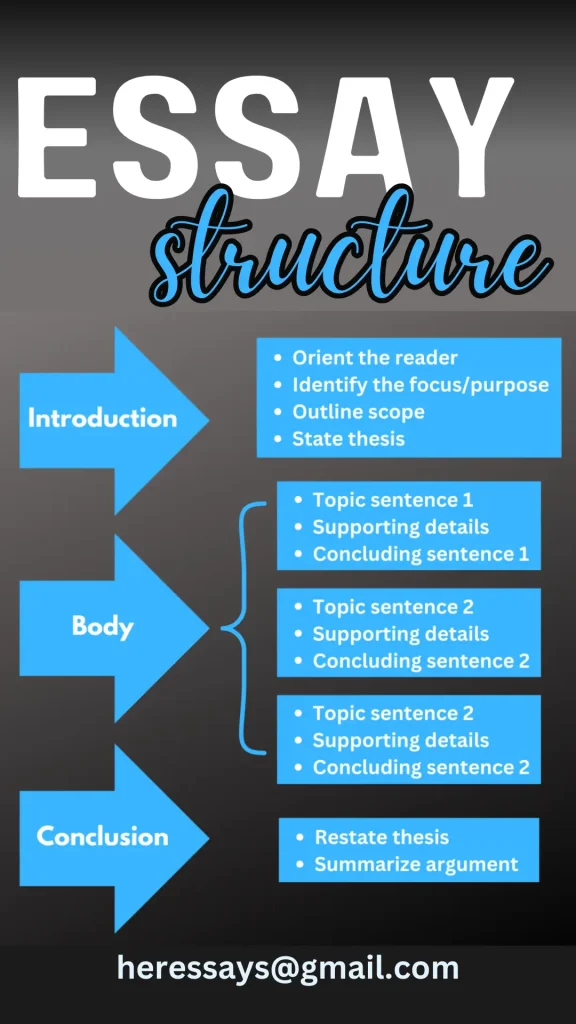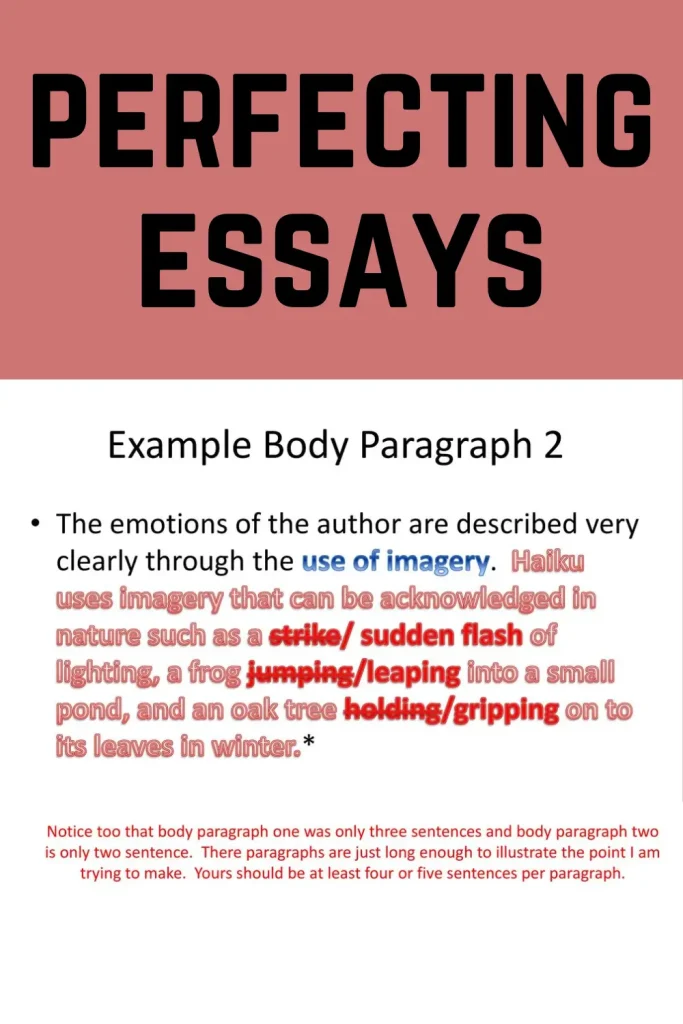
An academic essay is a formal piece of writing that presents a clear argument or analysis of a particular topic. Structuring an essay effectively is key to presenting ideas in a coherent and logical manner.
Here are the key points you will learn in this article:
- How to craft a strong and engaging introduction
- The role of a clear thesis statement in guiding your essay
- The structure of body paragraphs using the PEEL method (Point, Evidence, Explanation, Link)
- How to use evidence effectively to support your argument
- The importance of transitions for maintaining logical flow between paragraphs
- How to address counterarguments and alternative perspectives
- How to write a compelling conclusion that reinforces your main argument
The Introduction
The introduction is the first section of the essay, designed to set the stage for the argument. A well-crafted introduction does three key things:
- Engages the Reader: It captures the reader’s interest by presenting a relevant and engaging hook. The hook can be a thought-provoking question, an interesting fact, or a brief anecdote. It should be directly related to the essay topic and signal what the reader can expect.
- Provides Background Information: The introduction offers necessary context to help the reader understand the topic. This might include a brief overview of existing research, historical background, or definitions of key terms. Providing context is important to situate your argument within the broader academic conversation.
- Presents a Clear Thesis Statement: The thesis statement is the most important part of the introduction. It summarizes the main argument or purpose of the essay in one or two sentences. A strong thesis statement should be specific and concise, directly addressing the essay question or prompt. It serves as a roadmap for the essay, letting readers know what to expect in the body paragraphs.
Example of an Introduction:
Imagine you are writing an essay on the importance of renewable energy. An effective introduction might begin with a hook like this: “As the world faces unprecedented environmental challenges, the shift to renewable energy sources is no longer a choice but a necessity.” The next part would provide background, explaining the environmental issues and the growing demand for sustainable energy solutions. Finally, the thesis could state: “This essay argues that renewable energy sources are essential for combating climate change, promoting economic growth, and ensuring long-term energy security.”
Body Paragraphs

The body of the essay is where you develop your argument in detail. Each body paragraph should focus on one main idea, which supports the thesis. A well-structured body paragraph typically follows a pattern known as PEEL: Point, Evidence, Explanation, and Link.
1. Point
The point of the paragraph is its topic sentence. The topic sentence introduces the main idea of the paragraph and should clearly relate to the thesis. Every paragraph needs to begin with a strong topic sentence to ensure the reader knows what the paragraph will discuss.
2. Evidence
After presenting the point, you need to provide evidence to support it. This can come from various sources, such as academic articles, books, or reputable websites. Evidence is crucial because it gives weight and authority to your argument. The evidence could include statistics, quotations, or real-life examples. When using evidence, it’s essential to cite your sources properly according to the required citation style (such as APA or MLA).
3. Explanation
Following the evidence, you should explain how it supports the point. The explanation is your opportunity to analyze and interpret the evidence, linking it back to your thesis. This step ensures the reader understands the relevance of the evidence, preventing them from simply seeing it as an isolated fact.
4. Link
Each paragraph should conclude by linking the argument back to the main thesis or by transitioning to the next point. The link ensures the essay flows logically from one paragraph to the next, maintaining coherence throughout.
Example of a Body Paragraph:
Point: One of the most significant benefits of renewable energy is its potential to mitigate climate change.
Evidence: According to the International Energy Agency (2023), renewable energy sources like wind and solar can reduce global carbon emissions by 50% by 2030.
Explanation: This shows that adopting renewable energy can have a measurable impact on reducing the environmental damage caused by fossil fuels. By decreasing carbon emissions, countries can slow the rate of global warming and protect ecosystems.
Link: Therefore, promoting renewable energy is crucial for any long-term strategy to address climate change.
Developing Ideas Across Multiple Paragraphs
In longer essays, it is common for ideas to be developed over several paragraphs. In such cases, the first paragraph introduces the general concept, and subsequent paragraphs break down different aspects of the idea. This is especially useful when discussing complex topics that require a nuanced exploration.
For instance, if you are writing about renewable energy, one paragraph might discuss environmental benefits, while the next explores economic advantages. Each section remains linked to the overall thesis but allows for a deeper analysis of different facets of the argument.
Paragraph Transitions
Transitions are an essential element of essay structure that can enhance clarity and cohesion. Smooth transitions help guide the reader through your argument and avoid abrupt shifts in ideas. Effective transition words and phrases include:
- To introduce a new point: In addition, Furthermore, Similarly, Another key point is…
- To show contrast: However, On the other hand, Conversely…
- To provide an example: For instance, For example, Such as…
- To summarize: In summary, Therefore, As a result…
Example of a Transition Sentence:
“While renewable energy has undeniable environmental benefits, it also plays a crucial role in driving economic growth by creating jobs and reducing energy costs.”
Here, the transition shifts the focus from environmental advantages to economic benefits while maintaining a logical flow.
The Conclusion
The conclusion is the final section of the essay, where you summarize the main points and restate the thesis in light of the arguments made. A good conclusion does not introduce new information but reinforces the argument and leaves a lasting impression on the reader.
Key Elements of a Conclusion:
- Restating the Thesis: The thesis should be rephrased, not repeated verbatim. This reminds the reader of the central argument and ties together the entire essay.
- Summarizing Key Points: Briefly revisit the main points of the essay, highlighting how they support the thesis. This provides a concise review of the argument, helping the reader to see the bigger picture.
- Closing Statement: The final sentence should give a sense of closure. This could be a broader implication of the argument, a call to action, or a reflection on the significance of the topic. A strong closing statement leaves the reader with something to think about, making the essay more impactful.
Example of a Conclusion:
In conclusion, renewable energy is not just a viable alternative to fossil fuels; it is a necessary step in the fight against climate change. By reducing carbon emissions, promoting economic growth, and ensuring energy security, renewable energy offers a comprehensive solution to some of the most pressing global challenges. As we look to the future, the adoption of renewable energy technologies must accelerate to safeguard both our planet and our economies.
Additional Considerations for Essay Structure
1. Coherence and Cohesion
An academic essay must maintain coherence and cohesion throughout. Coherence refers to the logical progression of ideas, while cohesion refers to how well the sentences and paragraphs connect. Using appropriate transitions, consistent pronouns, and a clear structure helps ensure that the essay reads smoothly.
2. Balanced Argument
A strong academic essay not only presents one side of an argument but also considers counterarguments or alternative perspectives. Addressing potential objections to your thesis demonstrates critical thinking and shows a balanced, well-researched approach. When including counterarguments, make sure to refute them clearly and return to your main argument.
Example of Addressing a Counterargument:
Some critics argue that the initial costs of renewable energy infrastructure are prohibitively high. However, studies show that the long-term economic benefits, such as job creation and lower energy costs, far outweigh these initial investments.
3. Consistency in Style and Tone
Maintaining a consistent tone and style is essential in academic writing. Formal language, objective analysis, and an impersonal tone help convey authority and clarity. Avoid slang, overly casual expressions, and emotional language, as these can weaken the academic quality of your essay.
4. Word Count and Conciseness
While an academic essay must meet the required word count, it should also be concise and free of unnecessary filler. Every sentence should serve a purpose, contributing to the development of the argument. Editing and revising are key to ensuring that the essay remains focused and to the point.
Conclusion: The Importance of a Well-Structured Essay
In academic writing, structure is crucial to communicating ideas effectively. A well-organized essay, with a clear introduction, coherent body paragraphs, and a strong conclusion, allows for the logical development of an argument. Each section plays a unique role in guiding the reader through the essay’s points, making the argument easier to understand and more persuasive.
By following the guidelines outlined in this article, you can improve your essay w